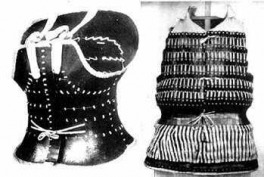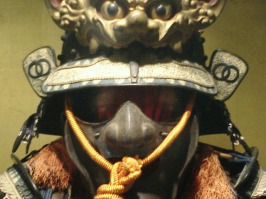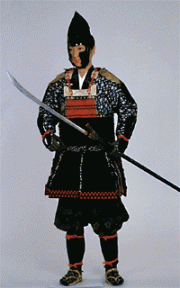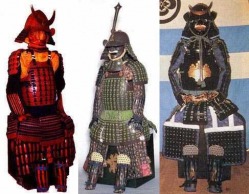History of Armor

ProtoHistory
The earliest Japanese armours were solid metal cuirasses made up of several sections of plate, often roughly triangular in form, which were tightly laced together and usually lacquered against rust. It is unclear what this armor was originally called, but some suggest the term kawara, which means "tile" or simply yoroi, which simply means “armour.” This style of armour has come to be called a tankô, which means "short armour."
The Early Middle Ages

The classic Japanese armour, the heavy, square, boxy suit, is now called ô-yoroi or "great armour,m” although it was originally called yoroi. The oldest extant ô-yoroi today is just boards made of scales laced together. Basically this means that it is no longer a solid, wearable piece of armour. We can still tell that it was a very elaborate armour, with six different colors of lacing in a pyramidal pattern. The armour, now in Ôyamazumi Jinja, was made in the first two decades of the tenth century. This armour shows one last remnant of keikô construction: the lacing ran straight down in vertical lines. Armours of only a few decades later developed the down, diagonal, and up again lacing pattern now regarded as standard.
High Middle Ages

During the Kamakura Period (1183-1333) the ô-yoroi was the principal armour of those of rank. The Samurai, however, found that the dô-maru was lighter and more comfortable than the ô-yoroi. The Samurai began to wear the dô-maru more and more often and by the middle of the Muromachi Period (1333-1568) the ô-yoroi wasn’t used as often.
The Late Medieval Period

The last half of the 16th century is often called the Sengoku Jidai, or Age of Battles. During this period of warfare, various daimyô vied for power and domination over their neighbors and rivals. Some even sought the ultimate prize of becoming the tenkabito, or ruler of the land. Only two people during this age were able to achieve something close to that: Oda Nobunaga (1534-1582) and Toyotomi Hideyoshi (1536-1598).
These five decades saw more developments, innovations, and refinements with armour than all of the previous five centuries. During this period, the way armour was developed changed greatly. The armour went from fully-laced scales, to sparse-laced scales, to sparse-laced lames, to riveted lames, to solid plates. Each of these steps meant the armours were cheaper and quicker to build than the models that came before them.
The Post-Period Period
After 1600, many different types of armours were developed, but their were unsuited for the battlefield. This armour was developed during the Pax Tokugawa, which is when war had vanished from daily life. The armour that is found in museums today are generally dated back to this period.
In 1700, Arai Hakuseki, a scholar, historian, and philosopher, wrote a piece glorifying the "ancient" forms of armour. Hakuseki criticized the fact that most armourers had forgotten how to make them and that people had forgotten how to wear them. His book resulted in a renaissance of older styles, produced some wonderfully eccentric suits.
In 1799, armour historian Sakakibara Kôzan was prompted to write a piece recalling the martial use of armour, in which he criticized the trend toward antiquarian armours made for the sake of antiquarianism. His book resulted in a second about-face in armour design, and again the armourers began to produce utilitarian and battle-worthy suits common to the 16th century.
